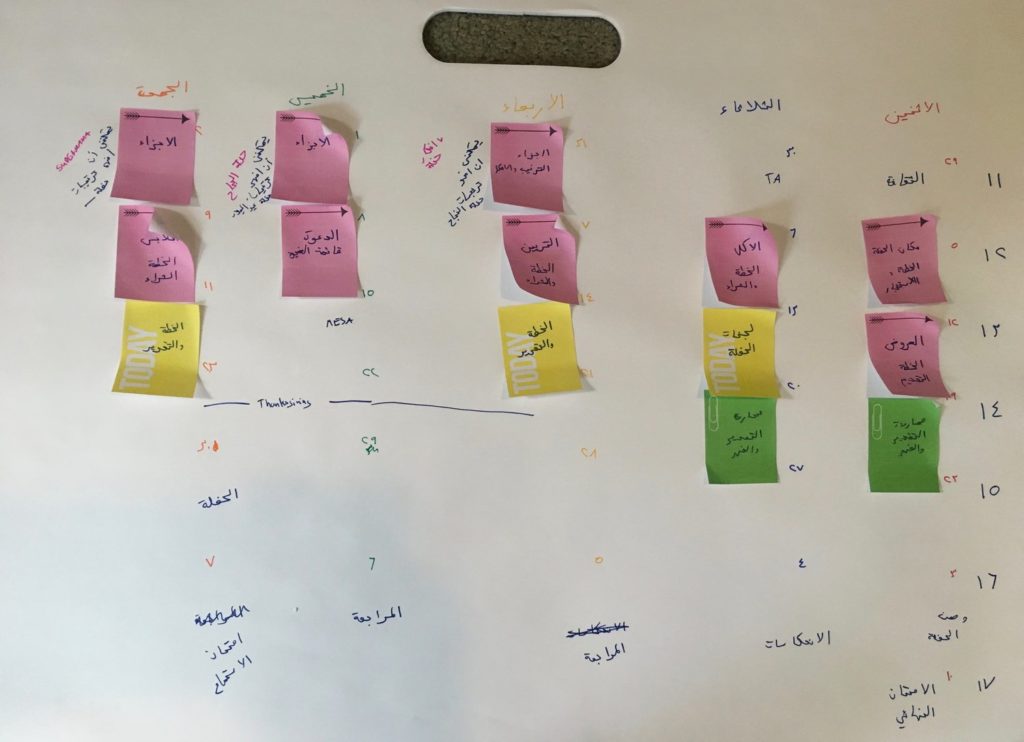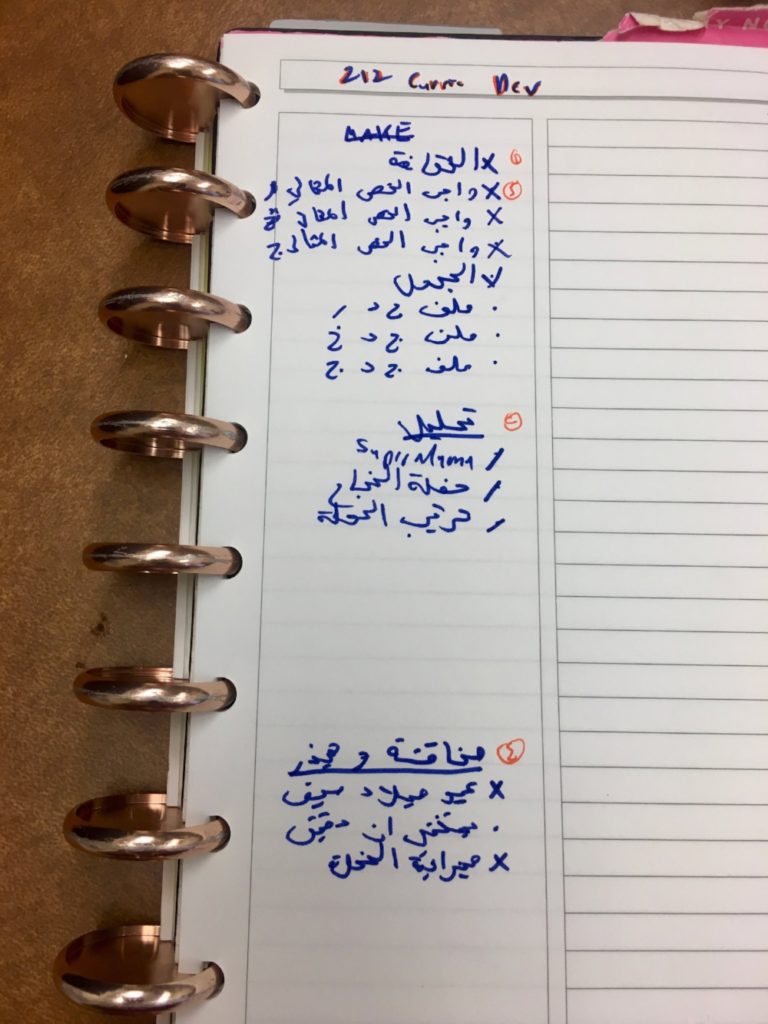As I mentioned in my previous curriculum development posts, this year in our Intermediate Arabic classroom we are moving away from the textbook and designing our own units informed by genre-based approaches to language learning. We are concluding our unit on housing, and starting our unit on planning an end of the year party. This is the unit I’m primarily responsible for developing, so I thought I would blog that process as I do it. In previous posts I’ve discussed background information, choosing assessment tasks, finding texts, and introducing intentional translanguaging pedagogy. In this post I’ll discuss making the unit plan and planning the first week of the party unit. The goal of this unit is to have students develop the skills to plan and carry out a language clubs mixer at the end of the semester.
Unit Planning

My first step in planning the overall unit was to map out the weeks for this unit on a large sheet of drawing paper (stolen from my kindergartener 😀). Here, I listed the weeks and days, and then referred to the original plan my co-teacher and I had made for the semesters to fill in holidays, conferences, and other events that occur in that time period. This left me with a specific number of days to work with. I then consulted our original idea about putting students in committees to plan a language clubs mixer/end of the year party as well as the texts I had found this summer representing language functions related to parties and party planning. Incidentally, I’m really glad I did that over the summer! Based on this, I used different colored post-its to plan out where these language functions could fit into the unit. I decided to start with texts describing the necessary steps for planning a party, then move to specific pieces of party planning (like ordering food or setting up entertainment), then students’ committee work, then some practice time. I was also able to leave a flex week to work in challenges we face as we get closer, and a reflection week for review and reflection after the event. If there’s anything I’ve learned in teaching and planning, it’s that you need to fit in some flex/buffer time to plan for the unexpected, and also some reflection time after the event or project!
Week 1
With a rough plan for the unit laid out, I moved on to planning Week 1 in detail, since that’s starting next week! At the start of each new unit, we include a culture day focused on that topic, where we ask students to research questions related to the unit at home, and then discuss them in class in small groups and then as a class. This is primarily in English, although, as in all parts of a language class, you’ll find some translanguaging as well. So, I put that on the schedule for Monday, and made a note for myself to create a culture assignment. Tuesday was already taken up finishing a telecollaboration assignment from the housing unit, so that left me with Wednesday, Thursday, and Friday to plan lessons working on understanding the steps of planning a party. For each day, following our incorporation of genre-based approaches, I would need Can-Do Statements related to the topic and an example text of these Can-Do Statements.
Since I knew that I wanted to focus on the steps in planning a party, I first looked at the texts I’d gathered over the summer on this topic to select the three I thought would work the best. I narrowed it down to an article on party planning generally, an article on planning a party celebrating someone’s success (since we are celebrating a successful semester inshallah!), and a video on planning a birthday party. I chose these texts from the ones I’d gathered because they were relatively short and had more accessible language (though my students will likely still find them quite challenging!).
With the texts selected, I made notes on my to-do list to analyze each text, create a homework sheet, and create a google drive chart for each text. I’ll explain these more later, but essentially because I didn’t have a big chunk of time to work on this unit, I needed to make clear notes to myself about what to do so I could do each task later, without first having to figure out what was it I needed to do again? As you can see in the picture, my list is in three categories: Make, Analyze, and Discuss.

I also focused on creating clear Can-Do Statements for each day. Although I have been writing Can-Do Statements since 2014 for our regular year and Summer STARTALK programs, it remains a challenge to write ones that are functional (e.g. I can describe what I did yesterday not I can use the past tense), specific enough (I can describe what I did yesterday, but not I can describe events in the past), and clearly assessable in a class period (I can describe what I did yesterday, but not I can talk about yesterday). So, for this upcoming week I tried to imagine how students would be performing language functions based on the texts and write examples based on that. I came up with the following, and then made a note on my to-do list to make a schedule for the students and teachers formatted appropriately.
Wednesday:
- I can write the steps of a successful party and my ideas for implementing them for our party
- I can present my ideas to the class
Thursday:
- I can write the steps for planning a party celebrating success and my ideas for implementing them in our party
- I can exchange my ideas with my classmates
Friday:
- I can write the steps to plan a child’s birthday party
- I can follow these steps in planning a birthday party for my teacher’s child
The next step was to analyze each text by making a list of vocabulary, grammar, pragmatics, sociolinguistics, and cultural information necessary to understand the text. Because I had time, I chose to analyze all the texts before making the homework related to them, but if I were more pressed for time I would analyze and then make the homework for each text. As I read or listened to each text (multiple times), I tried to pull out key elements in each category. For example the vocabulary included words like steps, confirm, reserve, decorations, etc. The grammar included the imperative form, as well as al-maSdar. The pragmatics column included works for giving advice, such as “be sure to” or “don’t ever”. The sociolinguistics category included features like the use of MSA or dialect, or the use of English for phrases like “party center”, and under culture I listed specific cultural information that would be important to understanding the text. Some of these would be obvious to my students (like a graduate cap) and some might be less obvious, like giving perfume/cologne as a party favor. Of course, there was also overlap between these categories, such as the use of the female second person imperative in two of the texts, indicating that the primary audience for these party planning texts is female.
I then drew from my analysis to plan the homework students would do for each text, and I’ll draw from it again when planning my lessons, as I couldn’t cram everything into the homework and review is helpful! For homework, we have students do two items: (1) an example text homework and (2) a google drive chart. The “example text homework” asks them what they understood and didn’t understand and prepares them to do specific tasks in class (as opposed to just asking comprehension questions). For these texts, I asked students to identify the party planning steps listed and items they understood and didn’t understand from each step. There is also a section where we try to draw students attention to what language they can identify in the text that will be useful for doing the Can-Dos in class. In the past, students have tended to focus on vocabulary and to some extent grammar, so for these texts I chose to specifically target sociolinguistics and pragmatics in these questions (such as who is the audience, how do you know? Or what are some possible reasons the article refers to “party center” in English rather than Arabic?). We’ll see how this goes.
In the google drive chart, we list linguistic features (usually vocabulary and grammar, but I’m trying to incorporate more pragmatic features) from the text and have students create sentences using these features that they can (in theory) use in class the next day to “do” the Can-Do Statement. We also allow students to add to the chart with words that are important to them. After class, we correct these sentences to give feedback. For this unit, I chose to copy or transcribe the example sentences from the texts themselves, to give students more context and also show how some of these words repeated throughout the text.
So, that’s week 1! Hopefully I’ll be back in a couple of weeks with a recap of how it went and plans for Week 2.

Leave a Reply